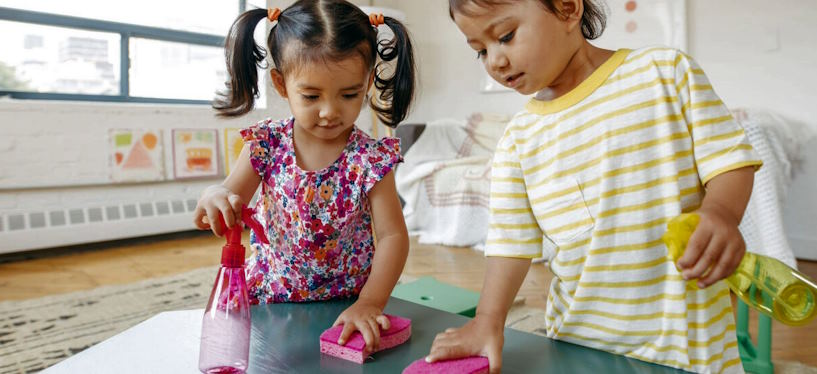
How To Teach Children To Clean?
Though it may appear challenging, teaching children cleaning skills is an investment in their development, nurturing responsibility, organizational abilities, and a feeling of actively contributing to the household.
How can parents do it?
Start Early with Simple Tasks
In the early years, initiate them with straightforward tasks like putting away toys or placing dirty clothes in a laundry basket. The emphasis here is not on perfection but on creating awareness that everyone plays a role in maintaining their shared space.
Make it Fun and Engaging
Transforming the cleaning process into an engaging and enjoyable activity is crucial. Incorporate elements of play, turning tasks into games or creative ventures. Whether it’s a musical cleaning session or a storytelling adventure while tidying up, making it fun helps children associate positive feelings with cleaning.
Lead by Example
Children are keen observers, and they learn best by seeing. Demonstrating good cleaning habits sets a powerful example. If they witness parents or caregivers maintaining cleanliness in shared spaces, they are more likely to adopt these behaviors. Leading by example establishes a norm and fosters a sense of shared responsibility.

Create a Cleaning Routine
Routine provides structure and predictability for children. Establishing a regular cleaning routine helps integrate cleaning seamlessly into their daily or weekly schedule. As they become accustomed to this rhythm, cleaning becomes a habitual part of their lives, reinforcing that maintaining their environment is a regular and necessary task.
Use Child-Friendly Cleaning Tools
Equipping children with tools tailored to their size makes cleaning more accessible and enjoyable. Child-sized brooms, dusters, and spray bottles provide a sense of ownership and agency. When they have tools designed for them, it empowers them to take an active role in the cleaning process.
Positive Reinforcement
Positive reinforcement is a potent motivator. Encourage and praise their efforts during and after cleaning activities. Acknowledge their contribution through verbal appreciation, a simple reward system, or a visible display of their achievements. It fosters a positive association with cleaning and reinforces the idea that their efforts are valued.
Remember, the journey of teaching children to clean is a shared adventure, a collaborative effort that, over time, transforms both the home and the individuals who inhabit it.









